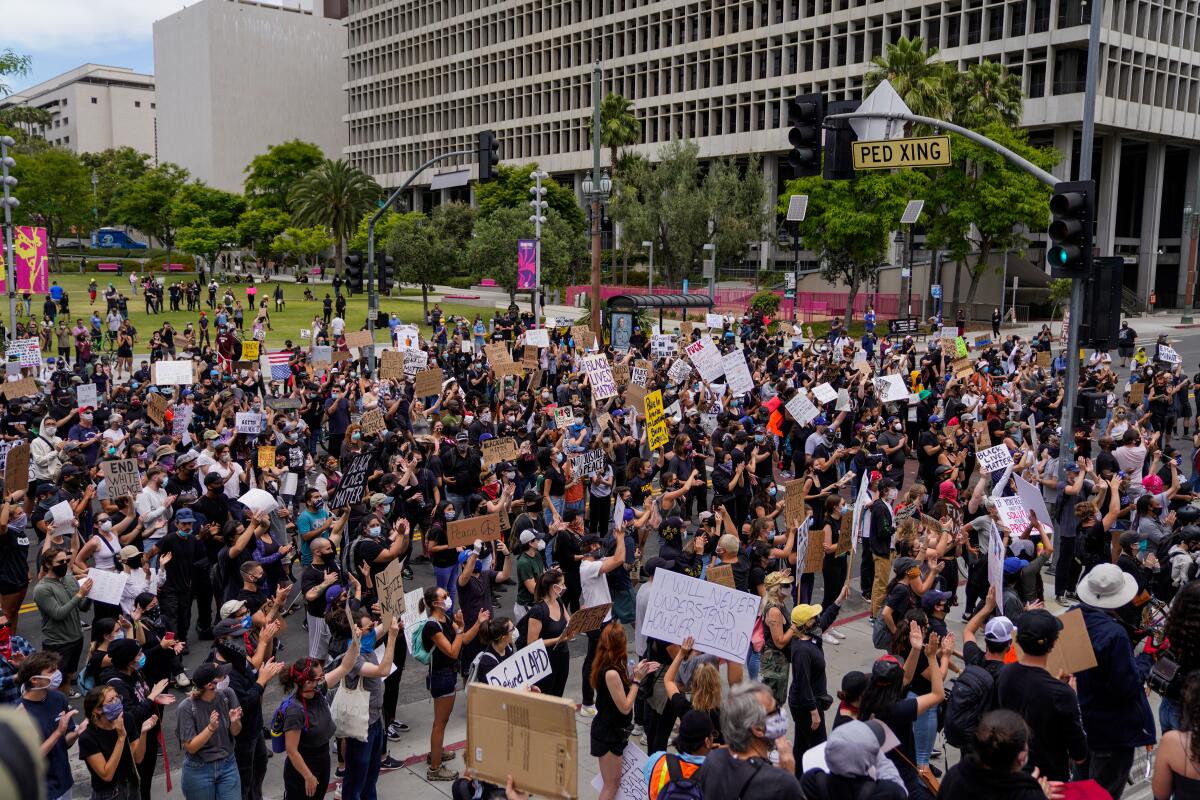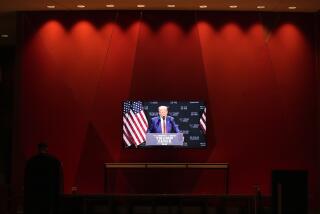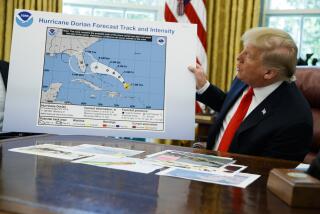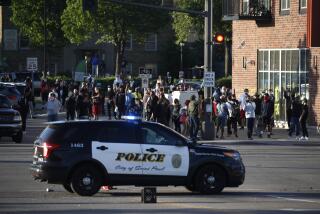Column: Donald Trump, urban warfare strategist, shares pacification tips

WASHINGTON — President Trump was never a mayor or a governor. He’s never served on a police force or in any branch of the military. He never tried to end a riot or apprehend a looter while protecting anyone’s constitutional rights.
But that shortage of relevant experience didn’t stop him from telling the nation’s governors how they should halt violent protests over police killings of African Americans.
“Most of you are weak,” Trump lectured the governors in a conference call Monday. “You have to dominate. If you don’t dominate, you’re wasting your time. They’re going to run over you. You’re going to look like a bunch of jerks.”
Officer Derek Chauvin was disciplined for pulling a woman from her car and frisking her during stop for speeding, one of 17 times he’s been investigated.
The solution, he told them, is simple: Put troops on the street and let them crack down. “You’ve got a big National Guard out there that’s ready to come in and fight like hell,” the president said.
Brute force has already restored peace to Minneapolis, Trump claimed. “They just walked right down the street, knocking [protesters] out with tear gas ... and you haven’t had any problems since.”
Actually, Minnesota Gov. Tim Walz replied, the crisis in Minneapolis isn’t over.
“The peaceful protesters are expressing an outrage that is real,” Walz, a Democrat, told the president evenly. “The next stage is trying to get those spaces for the peaceful protest and … [discussing] how do we get reforms.”
“I spent 24 years in the [National Guard],” the governor added. “You need to … make sure that it’s not seen as an occupying force.”
“It got so bad a few nights ago that the people wouldn’t have minded an occupying force,” Trump shot back.
A conservative Republican governor, Henry McMaster of South Carolina, ran into the president’s one-track mind as well.
“We have to be careful, but we’ve got to be tough,” McMaster said.
“You don’t have to be too careful,” Trump replied.
“The rhetoric that’s coming out of the White House is making it worse,” Illinois Gov. J.B. Pritzker told the president. “We have to call for calm.”
Trump’s reply: “I don’t like your rhetoric much either.”
A recording of the hourlong call, which leaked immediately, makes instructive but depressing listening. It’s a fly-on-the-wall microcosm of Trump’s flaws.
The governors try, ever so politely, to tell the president that repairing their states’ social fabric is more difficult than he thinks.
But Trump wants none of it. A few hours after the call, he announced that if a state fails to protect its citizens, “I will deploy the United States military and quickly solve the problem for them.”
It’s true that the National Guard can help secure city streets. That’s why 23 governors and the mayor of Washington, D.C., already had called up National Guard units before Trump told them they were “weak.”
But riot-trained National Guard troops are an imprecise instrument. They’re not designed for police work, like finding and arresting individual perpetrators.
More important, securing streets is only one part of what mayors and governors need to do in this crisis.
They also need to protect peaceful protesters — instead of tear-gassing them, as police did Monday to clear the way for a Trump photo op near the White House.
And they need to show that they are making serious efforts to root out the persistent racism in law enforcement agencies that has produced so many unjustified killings of African Americans.
Trump has barely mentioned those other, equal goals. On Monday, he claimed that he has decried George Floyd’s death in Minneapolis “with great compassion … in numerous speeches.” In fact, he’s mentioned it only a handful of times, only once at any length.
His prescription, ever since some protests spawned acts of violence, has been one-dimensional: overwhelming force.
“When the looting starts, the shooting starts,” he wrote on Twitter last week.
The president has long expressed admiration for the brutal force autocrats in other countries are able to use. “Strength” seems to be his favorite noun; “strongly” his go-to adverb.
He’s never had much patience for legal niceties or civil liberties. In 2017, he told an audience of police officers that they shouldn’t hesitate to be “rough” with suspects in their custody. “Please don’t be too nice,” he said.
Now, as he runs for reelection, he seems intent on reinforcing his self-image as a resolute strongman, especially among voters alarmed by shattered shop windows. “LAW & ORDER!” he shouted on Twitter.
If violent protests continue, he’ll say that’s not his fault; it’s because the governors are “weak” — just as he’s tried to make them responsible for dealing with the coronavirus pandemic after he bungled the federal response.
But if the violence dies down, he’ll congratulate himself for brilliant leadership.
“D.C. had no problems last night,” he tweeted Tuesday. “Many arrests … Overwhelming force. Domination. Likewise, Minneapolis was great (thank you, President Trump!).”
Over time, if history is any guide, the disturbances in most cities will recede. Police forces will gain control, with or without help from the National Guard. Protesters will tire of spending long days in the streets.
In well-run states and cities, governors and mayors — sheriffs and police chiefs, too — will work with community leaders to heal the wounds. Commissions will be formed. Police reforms will be proposed.
The president, in campaign mode, will demand praise he doesn’t deserve. But he’ll be playing the part of the noisy rooster who claims credit for the dawn.
More to Read
Get the L.A. Times Politics newsletter
Deeply reported insights into legislation, politics and policy from Sacramento, Washington and beyond. In your inbox three times per week.
You may occasionally receive promotional content from the Los Angeles Times.











